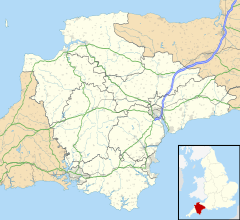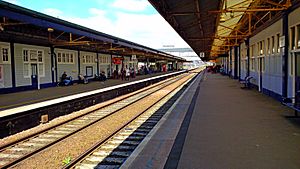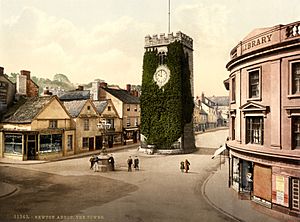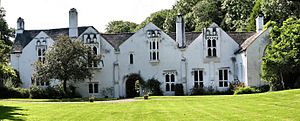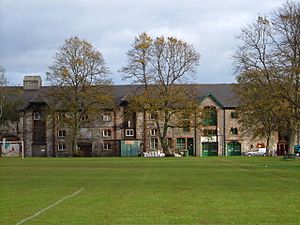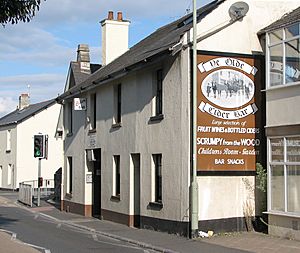Newton Abbot facts for kids
Quick facts for kids Newton Abbot |
|
|---|---|
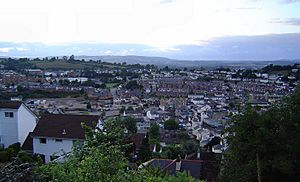 View over central Newton Abbot taken from Wolborough Hill, July 2005 |
|
Flag of Newton Abbot |
|
| Population | 25,556 (2011) |
| OS grid reference | SX860713 |
| Civil parish |
|
| District |
|
| Shire county | |
| Region | |
| Country | England |
| Sovereign state | United Kingdom |
| Post town | NEWTON ABBOT |
| Postcode district | TQ12 |
| Dialling code | 01626 |
| Police | Devon and Cornwall |
| Fire | Devon and Somerset |
| Ambulance | South Western |
| EU Parliament | South West England |
| UK Parliament |
|
Newton Abbot is a market town and civil parish on the River Teign in the Teignbridge District of Devon, England. Its 2011 population of 24,029 was estimated to reach 26,655 in 2019. It grew rapidly in the Victorian era as the home of the South Devon Railway locomotive works. This later became a major steam engine shed, retained to service British Railways diesel locomotives until 1981. It now houses the Brunel industrial estate. The town has a race course nearby, the most westerly in England, and a country park, Decoy. It is twinned with Besigheim in Germany and Ay in France.
History
Early history
Traces of Neolithic people have been found at Berry's Wood Hill Fort near Bradley Manor. This was a contour hill fort that enclosed about 11 acres (4.5 ha). Milber Down camp was built before the 1st century BC and was later briefly occupied by the Romans, whose coins have been found there.
The remains of a Norman motte-and-bailey castle, known as Castle Dyke, are on Highweek Hill. A village grew up around the castle, first called Teignwick, and later Highweek – the village on the high ground. Another settlement developed on the low ground around the River Lemon and would become part of Wolborough Manor.
The markets
The New Town of the Abbots (of Torre Abbey) was given the right to hold a weekly market on Wednesdays sometime between 1247 and 1251. By 1300 the two settlements were renamed as Newton Abbot (taking the low ground) and Newton Bushel (taking the high ground). On the strength of the market it quickly became a successful thriving town and a good source of income for the Abbots.
Over the river on the Highweek side another weekly market was created. This one ran on Tuesdays and, because the Bushel family were the landowners this community, became known as Newton Bushel. Over the next 200 years Newton Bushel ran more annual fairs, a number of mills were set up and the leather and wool trades started. Newton Bushel was also a convenient place for travellers to stay. Torre Abbey was dissolved in 1539 and ownership of Wolborough was granted to John Gaverock who built himself a new house at Forde.
The twin markets of Newton Abbot and Newton Bushel continued until they were merged in 1633 as a Wednesday weekly market under the ownership of Bradley Manor. By 1751 there was also a smaller Saturday market and three annual fairs—a cattle fair on 24 June, a cheese and onion fair in September and a cloth fair on 6 November. The markets continued to expand so in 1826 a new market was built. Over the next 50 years the buildings became dilapidated so a substantial new market was built in 1871. The buildings included a pannier market, a corn exchange and a public hall—the Alexandra (now a cinema). The river Lemon was also covered over. Further enlargement took place in 1938 as a new cattle market and corn exchange were built. There has been a thriving market in Newton Abbot for over 750 years.
Wool and leather
In medieval times Devon was an important sheep rearing county. Many towns had their own wool and cloth industries and Newton Abbot had woollen mills, fullers, dyers, spinners, weavers and tailors. In particular, fellmongering (where wool is removed from the sheepskin) was well established in the town. In 1724 Daniel Defoe wrote that Newton Abbot had a thriving serge industry that sent goods to Holland via Exeter. The annual cloth fair was the town's busiest fair. Over the 19th century Vicary's mills became an important employer in the town and by the 1920s they employed over 400 men. However, by 1972 business had declined and the works finally closed down.
Associated with the woollen industry was the leather one. The hides left after the fellmongering process were made into leather. Tanners, boot and shoe makers, glovers and saddlers were all in business in Newton Abbot. As with the wool industry business flourished over 600 years until after the Second World War.
The Newfoundland trade
In 1583 Humphrey Gilbert, a local adventurer, landed at St. John’s in Newfoundland and claimed the area as an English colony. The fisheries quickly developed. Between 1600 and 1850 there was a steady trade between Newton Abbot and the cod fisheries off Newfoundland. Every year men from the town would gather at the Dartmouth Inn or Newfoundland Inn in East Street in the hope of being hired for a season’s work. In the autumn the dried cod was stored in depots and sometimes used as payment. There was considerable economic spin-off from this trade. Fish hooks, knives, waterproof boots and rope were all made in the town. The Rope Walk to be found in East Street just a few yards from the Cider Bar still exists, together with the names of Newfoundland Way and St John’s Street.
Ball clay and the Stover Canal
Just 2 miles (3.2 km) northwest of Newton Abbot lie the large ball clay workings of the Bovey Basin. The main workings are on the eastern outcrop of the deposits at Kingsteignton, which can lay claim to being the centre of Britain's ball clay industry. The Bovey Basin took millions of years to fill from rivers that flowed out of Dartmoor. The sediments included clay derived from the decomposed granite. The natural deposition has resulted in a clay that is purer and more refined than many others. Clay is used in a wide range of products such as bricks, tyres, porcelain, glossy magazines, medicines and toothpaste.
Kingsteignton clay was being used to make pipes around 1680. By 1700, it was being shipped from Teignmouth, and its utilisation by the famous potter Josiah Wedgwood made it a success. The clay was extracted by simply digging out the lumps on courses—rather like peat cutting. The bulky clay was transported by packhorse to Hackney Quay at Kingsteignton, where it was loaded on to barges for shipment down the Teign Estuary, where it was transferred to small ships bound for Liverpool and other ports.
Towards the end of the 18th century, the ball clay industry was steadily expanding. A local landowner, James Templer, built the Stover Canal in 1792 to help ship clay along the canal and the Teign Estuary from the Bovey Basin to the port of Teignmouth. Coal, manure and agricultural produce was also freighted along the canal. James Templer's father, also called James Templer, purchased the 80,000-acre (320 km2) Stover Estate near Newton Abbot in 1765. Granite from Hay Tor was used to build Stover House which was completed by 1792. George Templer, son of James Templer (the second) and brother of Rev. John Templer, rector of Teigngrace, built the Haytor Granite Tramway, which had rails cut from granite, connecting the granite quarries of Haytor to the canal. This was completed by 1820 and enabled large quantities of granite to be transported for major works like the new London Bridge which opened in 1825. However, George Templer overspent his resources and was forced to sell Stover House, Stover Canal, the Haytor Granite Tramway and most of the rest of the family's considerable estates to Edward St Maur, 11th Duke of Somerset, in 1829. The canal was extended to cope with this, and the industry fared well until 1858 when they were out-competed by the more economic Cornish coastal quarries. The Stover canal reverted to shipping ball clay—which only really stopped by 1939.
The ball clay industry is now highly mechanised and very successful. The majority of the clay is now transported by road and transferred to ships at the nearby port of Teignmouth.
The Stover Canal Society was formed following a public meeting held in February 1999. The aims of the society are to preserve and restore the canal. Railtrack who owned most of the canal transferred ownership in 2005 for the sum of £1, to Teignbridge District Council for leisure use by the community. As of 2012 work was continuing towards restoring it as an amenity.
The railway
Newton Abbot railway station is situated at the east end of Queen Street. It is served by both local and long distance services.
The South Devon railway reached Newton Abbot in 1846, and changed it from simply a market town with associated trades (leather and wool) into an industrial base. The South Devon Railway Company opened the station on 30 December 1846. A branch to Torquay was added on 18 December 1848, and one to Moretonhampstead on 26 June 1866, though the latter since has closed to passengers. Isambard Kingdom Brunel used the Teignmouth / Newton Abbot section to experiment with his atmospheric railway. Brunel's experiment failed, but the remains of his pumping house buildings survive at Starcross and the old Dairy Crest milk processing factory in Totnes.
In 1876 the Great Western Railway bought up the railways and developed the repair and maintenance sheds into a substantial works that employed over 600 people to start with but by 1930 over 1,000 men were involved. Extensive sidings were also built making a large marshalling yard. The present station was rebuilt to its current form in 1927 to the designs by Chief GWR Architect PE Culverhouse. The large clock was gifted by the people of the town.
Many other industries were set up beside the railway station, including a timber yard, iron and brass foundries, and engineering works. The Newton Abbot power station was also built adjacent to the line on the Moretonhampstead branch. The town’s population increased from 1,623 in 1801 to 12,518 by 1901. Terraced streets were built to house the workers and attractively styled villas sprang up around the town for the wealthier professionals and retired people.
Modern history
The town was bombed twice in air raids during World War II, killing a total of 21. There was a severe flood on 27 December 1979, the latest in a long series, when the River Lemon burst its banks after prolonged rain.
Tucked into a corner of the racecourse, Newton Abbot's stock car track flourished for nearly 30 years, and attracted fans and drivers from all over the South of England. A short 300-metre oval track, it featured races for the cars of the BriSCA organization, as well as saloons and "bangers".
A new hospital to replace the one in East Street was built at the end of Jetty Marsh Road, and opened on 12 January 2009.
Landmarks
Alexandra Theatre (cinema)
The Alexandra was built in 1871. Originally it was built as a corn exchange at the end of the market building. However, before it was finished it was decided instead to use the space as a meeting hall for the community. It was called the Alexandra Hall and continued to be used for this purpose until in 1883 a major upgrade of the building took place which included the addition of a stage with dressing rooms below, more dressing rooms in extensions at the side of the main building and an orchestra pit. Many more alterations followed until it was converted into a two screen cinema in 1995.
St Leonard's Tower
The centre of the town features the ancient tower of St Leonard. The tower is all that remains of the medieval chapel of St Leonard, founded in 1220 and first referred to in 1350 in a document of the Bishop de Grandisson of Exeter, the main chapel being demolished in 1836 to ease traffic congestion. Adjacent to the tower is a plaque marking the spot where the first declaration of the newly arrived William III, Prince of Orange was read in 1688. It reads:
The first declaration of William III, Prince of Orange, the glorious defender of the Protestant religion and the liberties of England, was read on this pedestal by the Rev. John Reynell, rector of this parish, 5th November, 1688.
Although William arrived in Brixham on 5 November he did not reach Newton Abbot until 6 November when he stayed overnight in the town at Forde House as he made his way to London to assume the English throne.
Forde House
Forde House (now known as Old Forde House) is situated in the southeast corner of the town, in the parish of Wolborough. The present house was built in 1610 by Richard Reynell (who later became Sir Richard Reynell) and his wife Lucy. The house was built with an E-shaped floor plan, which is thought to be in honour of Queen Elizabeth I, who had recently died. The grounds were originally quite extensive, and included the whole of what is called Decoy (so named, because wildfowl were decoyed there to extend the house's larder), as well as a deer park.
In 1625 King Charles I stayed at the house overnight on his way to inspect the fleet at Plymouth. He returned a few days later and stayed for a further two nights. Forde House gave shelter to Oliver Cromwell and Colonel Fairfax while on their way to besiege Royalist Dartmouth in 1646. In 1648 the estate passed onto the Courtenay family via the marriage of Margaret (the only daughter of Jane Reynell and Sir William Waller) to Sir William Courtenay, who was the lord of nearby Powderham Castle. William of Orange stayed at the house in 1688 on the way to his coronation in London, having landed in Brixham a few days earlier. The house remained the main residence of a succession of Courtenays until 1762 when the house was let to a succession of occupiers.
The Courtenay family sold the house in 1936 to Mr Stephen Simpson, who sold it two years later to Mrs M Sellick. Teignbridge District Council bought the house in 1978 and remain the current owners. It has been refurbished by the Council and is now used as office and conference space as well as being used for weddings and other events.
Bradley Manor
At the opposite end of Newton Abbot is the National Trust property, Bradley Manor. This is a 15th-century (circa 1420) manor house in its own secluded woodland setting, with a notable great hall emblazoned with the royal coat of arms of Elizabeth I.
The Passmore Edwards Public Library
John Passmore Edwards originally wanted to have a hospital built for the town in memory of his mother, who was born there. However, as the town already had a hospital, he decided on a public library, which was opened in 1904. The building is one of the most impressive in Newton Abbot, and originally housed both the library and a Science, Art and Technical School (which the Council wanted to include). The building was designed by the Cornish architect Silvanus Trevail. The style is elaborate Renaissance, and much use is made of yellow terracotta mouldings over the windows and doorways. Passmore Edwards donated £2,500, while the County Council and a public subscription paid for the rest of the building.
The building was renovated in 2010–2012. On re-opening it was renamed the Passmore Edwards Centre in honour of its benefactor and to reflect its future as a multi-purpose facility. The Library now works closely with Coombeshead Academy.
Almshouses
There are several sets of almshouses in Newton Abbot.
- Gilberd's in Exeter Road were endowed in 1538 by John Gilberd of Compton Castle to house lepers. There were five houses and they reputedly had sloping floors to help in washing out the houses. Eight modern apartments with a common room and visitors bedroom now occupy the site, which is administered by the Feoffees of Highweek.
- In 1576 Robert Hayman set up a number of houses for poor people in East Street. These were rebuilt in 1840.
- Reynell's almshouses were originally built in 1640 beside Torquay Road to house four clergy widows ("the relicts of preaching ministers, left poor, without a house of their own") These were rebuilt in 1845.
- Mackrell's almshouses in Wolborough Street were built in 1874 by J. W. Rowell. Mackrell was a native of Newton Abbot who made his fortune as a chemist in Barnstaple. Mackrell also funded a home in the Forde Park area for the "fallen women of Newton Abbot", which housed single mothers fallen on hard times.
The workhouse
The original Newton Abbot poorhouse was based in East Street, and the cellar of the Devon Arms was used as the oakum picking room—where paupers were assigned the unpleasant job of untwisting old rope to provide oakum, used to seal the seams of wooden boats. Newton Bushel had its own poorhouse, not far from present day Newton Abbot Leisure Centre, previously known as Dyron's.
The 1834 Poor Law Act required changes and incorporation, so in 1839, a new workhouse was built in East Street and was used to house paupers from the surrounding areas. Over time, the workhouse became more of a hospital for the sick, infirm and aged poor. By 1890 there were nearly 400 inmates, and reports of cruel treatment. A new infirmary was built, and during the wars some of the buildings were used as a military hospital. By 1950, the workhouse buildings were incorporated into the hospital in East Street. The entire site has now been redeveloped.
Tucker's Maltings
Close to the railway station is Tucker's Maltings, the only traditional malthouse in the UK open to the public. The malthouse—which offers the visitor hour-long guided tours, from the barley to beer discovery centre—produces malt for over 30 breweries, and enough to brew 15 million pints of beer per annum. In April every year, the maltings hosts a three-day beer festival where over 200 different real ales can be sampled.
Ye Olde Cider Bar
Said to be one of only two remaining cider houses in the United Kingdom, Ye Olde Cider Bar in East Street sells only cider, perry, country wines and soft drinks. Its interior and the simple wooden furniture have remained relatively unchanged for over thirty years. However some of the old customs associated with the bar such as limiting women and holiday makers to half pint measures and covering the floor with sawdust have now gone.
Newton Abbot Town & G.W.R. Museum
A small museum adjacent to the town hall details the history of Newton Abbot and of the Great Western Railway.
Sport and leisure
Newton Abbot has two non-league football clubs: Buckland Athletic F.C., which plays at Homers Heath, and Newton Abbot Spurs A.F.C., which plays at the Recreation Ground. The headquarters of Devon County Football Association are in the town.
Newton Abbot's South Devon Cricket Club was established in 1851 and also plays at the Recreation Ground.
The town has a long-standing rugby union club, Newton Abbot RFC (established 1873), which plays home games at Rackerhayes in nearby Kingsteignton.
Two greyhound racing tracks existed; the Newton Abbot Greyhound Track lasted from 1974 to 2005 and a short-lived track was laid on the Recreation Ground, where Newton Abbot Spurs plays today. The racing was independent (unaffiliated to the sports governing body, the National Greyhound Racing Club) and so both were known as flapping tracks, a name given to independent tracks. Distances there were 250, 450 and 460 yards and racing lasted about five years.
Education
Coombeshead Academy is a comprehensive school in Coombeshead Road. It is a trust school and a specialist media and arts college for some 1,442 pupils aged 11 to 18.
Newton Abbot College, also a comprehensive school in Old Exeter Road. It came into being on 1 September 2008 as a renaming of Knowles Hill School. It is a specialist Technology College for around 1,200 pupils aged 11 to 18.
South Devon UTC is a university technical college in Kingsteignton Road, established on 1 September 2015 for pupils aged 14 to 19.
The local primary schools include St Joseph's Roman Catholic Primary, Decoy Primary, which has been awarded the Becta ICT Mark, Eco and Healthy School awards, as well as Bearnes Primary, Canada Hill Primary, Wolborough C of E Primary, Bishop Dunstan School, Bradley Barton Primary, and Haytor View Primary.
Notable people
- John Angel, sculptor, born here in 1881. He designed the Exeter War Memorial and emigrated to America, where he did much ecclesiastical carving.
- Sir Samuel White Baker, explorer, big-game hunter, writer and abolitionist, bought the Sandford Orleigh estate in 1874 and died there in 1893. Baker's Park in the south-west of the town is named after him.
- Norah Baring, movie actress, was born here in 1907.
- Don Bird, professional footballer, was born here in 1908.
- Len Coldwell, cricketer, was born here in 1933.
- William Knox D'Arcy, a founder of the petroleum industry in Persia, was born here in 1849.
- Anna Harriett Drury (1824–1912), novelist, poet and writer of boys' stories, lived here for 46 years and died here.
- Hiley Edwards, a cricketer who played for and captained Devon, was born here in 1951.
- Frank Harry, first-class cricketer, was born here in 1876.
- Robert Hayman, poet, and governor of Newfoundland, was born in Wolborough, now part of Newton Abbot, in 1575.
- Oliver Heaviside, the physicist, lived here from 1897 to 1909.
- John Lethbridge invented a diving salvage machine in 1715.
- Frank Matcham, a theatrical architect, was born here in 1854.
- Edith Mayne, freestyle swimmer, was born here in 1905.
- Paul Mount, modernist sculptor, was born here in 1922.
- Rupert Neve, audio electronics engineer and entrepreneur, was born here in 1926
- John Baptist Lucius Noel, mountaineer and film-maker best known for his film of the 1924 Mount Everest expedition, was born here in 1890.
- Robert Cyril Layton Perkins (1866–1955), entomologist, retired here in 1912.
- Sergio Pizzorno, guitarist and songwriter with band Kasabian, was born here in 1980.
- Anthea Redfern, television hostess, was born here in 1948.
- General Sir Leslie Rundle, a British Army general, was born here in 1856.
- Lewis Tessier, merchant and political figure in Newfoundland, was born here in 1820.
- Fred Thompson, writer and librettist was born in London in 1884, but raised here.
- Peter Truscott, Baron Truscott, peer, petroleum and mining consultant, and writer, was born here in 1959.
- David Vine, TV sports presenter, was born here in 1935.
- Ollie Watkins, Aston Villa and England national football team footballer, grew up here.
- John Wilcox, cricketer, was born here in 1940.
- Ivy Williams, the first woman to be called to the English bar, was born here in 1877.
Images for kids
See also
 In Spanish: Newton Abbot para niños
In Spanish: Newton Abbot para niños


